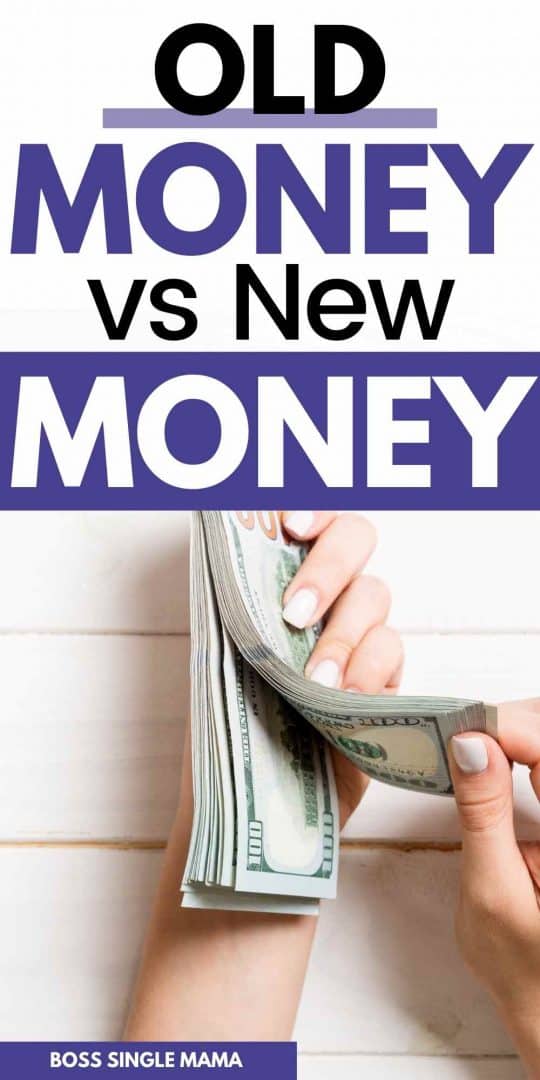Last Updated on January 23, 2022 by Rebecca Lake
Old Money vs New Money
Old money vs new money–is there a major difference? And does it matter?
“Old money” generally means inherited wealth that’s passed down from generation to generation. “New money”, on the other hand, means wealth that’s acquired by the current generation.
The Rockefellers and the Vanderbilts are two well-known examples of old money families. Elon Musk and Jeff Bezos are prime examples of new money people who built first generation wealth.
If you’ve ever read “The Great Gatsby” you’re probably familiar with the old money vs new money debate. F. Scott Fitzgerald wrote the novel as an ode to the Jazz Age and his conflicted feelings about the new money culture it gave birth to.
In the book, Daisy Buchanan is the epitome of old wealth and Gatsby’s ideal of the American Dream. Tom Buchanan, meanwhile, represents everything that Gatsby resents and despises about the old money class.
Edith Wharton was another American novelist who wrote about the new money vs old money clash. She drew on her insider knowledge as a member of an old money family to describe life in New York City’s upper crust in novels like “The Age of Innocence”.
Old money and new money describe how someone comes by their wealth. But the type of wealth someone has can influence their spending habits and their social perception by others in the general public.
Today, I’m explaining just what it means to have new money vs old money.
Related post: How to Get Rich From Nothing: 10 Secrets of Millionaires

LIKE FREE MONEY?
Here are some of my go-to apps for earning extra cash!
Survey Junkie. Earn up to $50 per survey just for sharing your opinions.
Swagbucks. Make money by playing games and watching videos. Join for free and get a $10 bonus when you sign up!
InboxDollars. Take surveys and get paid, no special skills or experience required!
Rakuten. Earn up to 40% cash back at hundreds of retailers, online or in stores. And get $30 for each person you refer, along with a $10 sign up bonus!
CashApp. Need a simple app for sending and receiving money? Get $5 free when you use code ‘VZXRXZN’ to join CashApp.
What Is Old Money?
Old money means inherited wealth that goes back to previous generations. Someone who has old money is an affluent or wealthy person.
Families that have old money have higher social standing and belong to the upper class. They’re more than just rich people; there’s a good chance their family name is often synonymous with wealth and prestige.
Oddly enough, some of the most well-known old money families in the United States didn’t start off that way.

John Jacob Astor, for example, was a poor German immigrant who built a family fortune through the booming fur trade following the Revolutionary War. Andrew Carnegie was a Scottish immigrant who became one of the richest people in America through investment in the steel industry.
These men, along with Cornelius Vanderbilt, E.I. DuPont and John D. Rockefeller, were robber barons who managed to amass vast amounts of wealth as entrepreneurs and investors.
In Europe and other parts of the world, meanwhile, old money families may belong to the nobility or aristocracy. They have multi generation wealth and inscrutable social connections.
The British royal family is an example of old money. Other European family names associated with old money include Rothschild, Wendel and Agnelli.
Related post: How Much Is 7 Figures in Money? (7,8,9 and 10 Figures Explained)
What Is New Money?
New money is wealth that’s earned through hard work, rather than inherited from one generation to the next.
That’s a major difference from old money.
Someone who has new money may have earned it by building a successful business. Or they may be professional athletes, TV stars, celebrities or other individuals with a rare skill that allows them to make a lot of money.
In simple terms, they’re part of the nouveau riche. Examples of fictional new money families include the Youngs from “Crazy Rich Asians” or Jay Gatsby.
New money people tend to have a different social perception and social standing than those with old money. While there are rich people on both sides, there’s an elevated social status that goes along with having old money.

Caroline Schermerhorn Astor is a great example of the old money vs new money attitude. Known as “the Mrs. Astor”, she was a prominent New York City socialite and mother of John Jacob Astor IV, who notably died on the Titanic.
As the unofficial gatekeeper to New York society, Mrs. Astor had a less-than-cordial relationship with the Vanderbilts who were still considered “new money” at the turn of the 20th century. It wasn’t until she gave in and invited the Vanderbilts to the annual Astor ball that they were formally accepted into the ranks of the city’s fashionable upper class families.
Mark Zuckerberg is one example of new money; Bill Gates is another. While both are incredibly rich, they likely would have been snubbed by old money families during the Gilded Age.
Why?
One reason. They’d have had the cash to make the cut but not necessarily the social class or standing.
Related post: Left Hand Itching? What Itchy Palms Mean for Your Money
Old Money vs New Money: Key Differences
The key difference between old money vs new money typically lies in where someone’s wealth comes from. But things like spending habits, social position and social perception can also distinguish one wealthy family from another.
Source of wealth
Old money is money that’s inherited from one generation to the next. Someone who’s part of the old money set has a lot of money because someone else in their family first created that wealth.
Again, many old money families in the United States are descended from robber barons and early industrialists who figured out how to capitalize on an expanding economy.
New money families, on the other hand, typically earned their wealth in this generation or the previous one. For example, Sam Walton earned a tremendous amount of money building Walmart into one of the best-known legacy brands in the U.S.

Social standing and social perception
Old money people typically have a higher social standing and more impressive social connections than new generation money. In traditional cultures, family honor is also an important component of the old money mindset.
This class of people may limit their social circles to other old money families, a la Mrs. Astor. Their family name often precedes them and they may have a reputation for being more cultured, refined or respected.
Some old money families are associated with a specific geographic area. The Astors and Lauders (of Estee Lauder fame), for example, are associated with New York City.
Children of old money families may have a competitive advantage when it comes to getting into the best elementary school, high school or college. Or they may engage in hobbies that are often associated with the typical old money lifestyle, like yachting or polo.
New money families, meanwhile, may only hobnob with other new money families.
They may be viewed as being lower-upper class because they have new wealth instead of old wealth. Or they may flaunt their wealth on social media, something old money individuals might consider improper.
In terms of geography, you’re likely to come across new money families in places like Los Angeles, Silicon Valley and Seattle. The West Coast in general is home to plenty of tech billionaires and millionaires, for example.
Elon Musk is an outlier. He’s a new money billionaire who reportedly lives in a prefab tiny home in Texas.
Related post: Right Hand Itching? (Why Your Itchy Palms Could Be a Good Luck Charm)
Spending habits
One of the major differences in old money vs new money lies in how wealth is managed.
With old money individuals, there may be a certain degree of respect attached to family wealth. And there may be an interest in preserving wealth for the next generation.
That doesn’t mean the richest families don’t spend money on luxury cars, Beverly Hills real estate or expensive vacations. But they balance that by spending money on things like private school for their children or investing in things that will continue to grow wealth for future generations.
Some of the wealthiest old money families also have a legacy of giving money away. The Rockefellers, for instance, have a lengthy history of philanthropy.
Old wealth families take financial planning seriously. People with old money may hire multiple financial advisors or use a family office for wealth management.
Does that mean new money people squander their riches or flaunt their wealth?
Not necessarily.
(Though there is a wealthy businesswoman named Lisa Marie Brown who tools around Londin in a pink Ferrari. And Mike Tyson did once spend over $200,000 to purchase three Bengal tigers.)
They may or may not seek to draw much attention to their wealthy status. And there are plenty of people who engage in a practice known as stealth wealth.
They’re new money rich but you can’t always tell because they may not drive an expensive car, for example.
They’re not in a hurry to upgrade their current home for something bigger. If they have dinner out, it’s at their favorite restaurant instead of the most high-end spots. And when it comes to clothes, they may stick with a classic style instead of splurging on designer fashions.
This is the kind of new money wealth that’s described in the book “The Millionaire Next Door”. The book’s authors describe how the typical millionaire in the United States lives, which isn’t all that flashy.
There can also be a big difference in attitudes between old money vs new money when it comes to passing wealth on their kids.
People who are part of the new money class may not pay for private education for their children or be hyper-focused on creating generational wealth. Warren Buffett, for example, has said he’ll give away 99% of his billions rather than leaving it all to his kids.
New Money vs Old Money: Which Is Better?
Whether you value new money vs old money more can depend on your perspective.
For someone who was born into poverty and has managed to build wealth through their hard work ethic, there may be nothing wrong at all with having new money.
In fact, a lot of people would probably be happy to have new money when you consider that 10% of people in the U.S. own 70% of the country’s collective wealth while millions more spend their entire lives living in poverty.
If you’re part of the old money set, you may look down on new wealth. Then again, you may not.
It can really depend on how you were raised to think about money. If you were taught that money is a tool and that it should be used to help those less fortunate, then you may not distinguish between old money vs new money.
On the other hand, if you were raised to believe that wealthy families shouldn’t associate with the lower class then you might have a more negative view of new money.
I believe that having old money or new money doesn’t make someone better or worse than anyone else.
I grew up in poverty and many of my family members are blue-collar working class. I’ve been dirt-poor, broke and financially stable at different times. For me, money is a resource and what you do with it to improve your life and the lives of others is the only thing that really matters.
And here’s something that’s interesting: Current trends show that the number of millionaires in the United States is growing.
So old money families could soon find themselves rubbing elbows with new money families more often.

When does new money become old money?
There’s no set time frame for when new money becomes old money. A certain number of years or generations doesn’t need to pass for new money to automatically become old money.
Typically, it’s other distinctions that set wealthy people apart from one another. Again, it all goes back to how wealth is made and what social class or lifestyle that translates to.
Does net worth matter when talking about new money vs old money?
Net worth measures the relationship between assets and liabilities. It’s the difference between what you own and what you owe.
A higher net worth doesn’t automatically distinguish someone as new money vs old money.
Elon Musk, for example, is as new money as it gets and he’s one of the top 10 richest people in the world, along with Jeff Bezos, Bill Gates, Mark Zuckerberg, Larry Page and Warren Buffett.
So no, net worth doesn’t matter for determining old money vs new money status.
But knowing your own net worth is important for building wealth and achieving your financial goals.
Related post: How Much Is 6 Figures in Money?
Final thoughts on old money vs new money
The new money vs old money debate will likely continue as long as generational wealth exists and new millionaires and billionaires are made.
If you’re interested in creating more wealth of your own, paying down debt and growing your income are two ways to do it. It wasn’t until I started making more money that I saw a definite improvement in my net worth.
So if you don’t have old money, new money or any money at all don’t panic. Instead, focus on what you can do to improve your financial situation by making smart money decisions.
For example, you can open an account with M1 Finance to start investing. All you need is $100 to begin building wealth.
Or you could work on creating multiple streams of income. Bottom line, being proactive can help you develop good money habits that stand the test of time.
Need some ideas for easy ways to make more money? Check out my ultimate resource page for increasing your income!

